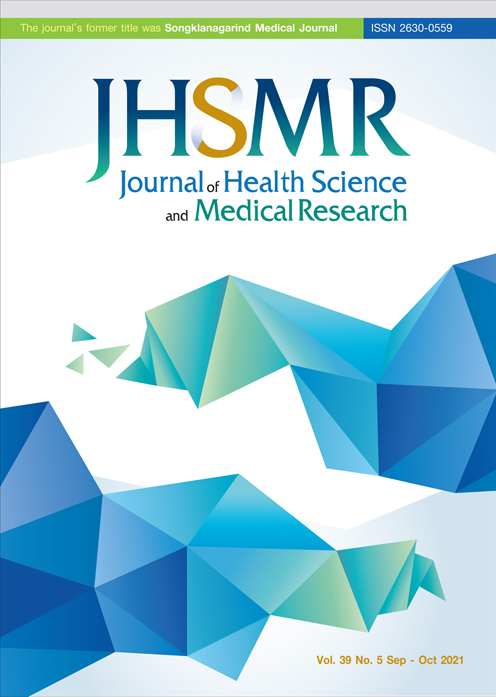Risk Factors for Postinduction Hypotension among Elderly Patients Undergoing Elective Non-Cardiac Surgery under General Anesthesia
DOI:
https://doi.org/10.31584/jhsmr.2021795Keywords:
elderly, hypotension, post-induction, risk factorsAbstract
Objective: We aimed to determine risk factors for hypotension occurring after induction among elderly patients (aged 65 years and older). We hypothesized that the dosage of intravenous anesthesia drugs as well as the type of inhalation agent have an effect on hypotension during post-induction periods. We aimed to test this hypothesis to determine risk factors for hypotension after induction among elderly patients who underwent non-cardiac surgery.
Material and Methods: This retrospective cohort study analyzed data from 580 patients between December 2017 and July 2018 at a tertiary university hospital in the south of Thailand. Hypotension is defined as a more than 30.0% decrease in mean arterial pressure from baseline after induction and within 20 minutes of the use of a vasopressor agent to treat hypotension. The intraoperative parameters were blood pressure and heart rate immediately after arrival at the operating room, immediately after intubation, and 5, 10, 15, and 20 minutes after intubation.
Results: The median age was 72.5 (68, 78) years. The association of post-induction hypotension was raised with a diuretic drug as preoperative medication (p-value=0.025), and the degree of hypertension immediately after arrival at the operating room (p-value<0.001). Increasing fentanyl dosage during induction was associated with hypotension (p-value<0.010). There was no statistically significant difference in the increase of the propofol dosage.
Conclusion: The degree of hypertension immediately after arrival at the operating room coupled with higher fentanyl dosage were significant risk factors for postinduction hypotension in elderly patients.
References
Monk TG, Mangione MP, Nguyen JD, Hammermeister KE. Association between intraoperative hypotension and hypertension and 30-day postoperative mortality in noncardiac surgery. Multicenter Study 2015;123:307-19.
Walsh M, Devereaux PJ, Garg AX, Kurz A, Turan A, Rodseth RN, et al. Relationship between intraoperative mean arterial pressure and clinical outcomes after noncardiac surgery: toward an empirical definition of hypotension. Anesthesiology 2013;119:507–15.
Reich DL, Bodian CA, Krol M, Kuroda M, Osinski T, Thys DM. Intraoperative hemodynamic predictors of mortality, stroke, and myocardial infarction after coronary artery bypass surgery. Anesth Analg 1999;89:814-22.
Ida M, Kimoto K, Iwata M, Nakayama K, Kamiya T, Kuzumoto N, et al. Retrospective evaluation of predictors and frequency of hypotension in hypertensive patients after induction of general anesthesia. Masui 2014;63:614–8.
Reich DL, Hossain S, Krol M, Baez B, Patel P, Bernstein A, et al. Predictors of hypotension after induction of general anesthesia. Anesth Analg 2005;101:622–8.
Südfeld S, Brechnitz S, Wagner JY, Reese PC, Pinnschmidt HO, Reuter DA, et al. Post-induction hypotension and early intraoperative hypotension associated with general anaesthesia. Br J Anaesth 2017;119:57–64.
Robinson BJ, Ebert TJ, O’Brien TJ, Colinco MD, Muzi M. Mechanisms whereby propofol mediates peripheral vasodilation in humans. Sympathoinhibition or direct vascular relaxation? Anesthesiology 1997;86:64–72.
Bijker JB, Klei WA van, Kappen TH, Wolfswinkel L van, Moons KGM, Kalkman CJ. Incidence of intraoperative hypotension as a function of the chosen definition literature definitions applied to a retrospective cohort using automated data collection. Anesthes 2007;107:213–20.
Jor O, Maca J, Koutna J, Gemrotova M, Vymazal T, Litschmannova M, et al. Hypotension after induction of general anesthesia: occurrence, risk factors, and therapy. A prospective multicentre observational study. J Anesth 2018;19:1–8.
Kanonidou Z, Karystianou G. Anesthesia for the elderly. Hippokratia 2007;11:175–7.
Cheung CC, Martyn A, Campbell N, Frost S, Gilbert K, Michota F, et al. Predictors of intraoperative hypotension and bradycardia. Am J Med 2015;128:532–8.
Bijker JB, Persoon S, Peelen LM, Moons KG, Kalkman CJ, Kappelle LJ, et al. Intraoperative hypotension and perioperative ischemic stroke after general surgery. Anesthesiology 2012;116:658–64.
Colson P, Gaudard P. Hypertension and anesthesia: what’s new?. J Hypertens Manag 2016:2. doi: 10.23937/2474-3690/ 1510013.
Anastasian ZH, Gaudet JG, Connolly ES, Arunajadai S, Heyer EJ. The effect of antihypertensive class on intraoperative pressor requirements during carotid endarterectomy. Anesth Analg 2011;112:1452–60.
Khan NA, Campbell NR, Frost SD, Gilbert K, Michota FA, Usmani A, et al. Risk of intraoperative hypotension with loop diuretics: a randomized controlled trial. Randomized Controlled Trial 2010;123:1059.e1-8.
Downloads
Published
How to Cite
Issue
Section
License

This work is licensed under a Creative Commons Attribution-NonCommercial-NoDerivatives 4.0 International License.
























